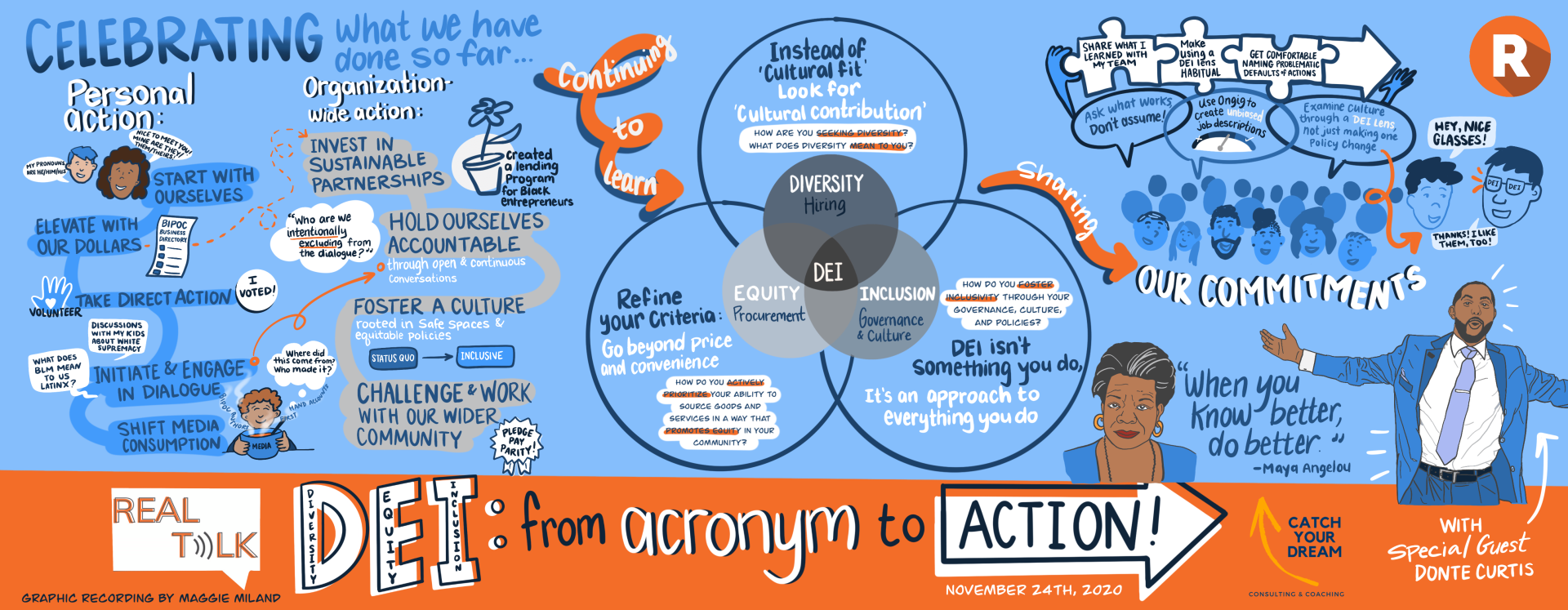DEI: From Acronym to Action
Published on December 10, 2020
What’s stopping your workplace from taking practical action to become more diverse, equitable, and inclusive?
This was the topic we dove into at our DEI workshop with more than 45 passionate leaders and change makers from multiple sectors and across Canada and the U.S. Led by the inspiring Donte Curtis, Lead Consultant and Founder of Catch Your Dream Consulting, we all took an honest and critical assessment of our current practices and collaborated to develop solutions to:
- Hire more diversely;
- Foster inclusive governance and culture; and
- Be more equitable in our business procurement practices.
Daunting stuff, no? While we don’t shy away from tackling big problems like workplace diversity, equity, and inclusion (DEI), we also don’t want our Real Talk workshops to only be theoretical exercises with just talk and no action. Real Talk is about learning and collaborating with engaged leaders across all sectors to devise practical actions and solutions to big problems.
“Don’t let anybody or anything make you hopeless. Hope is the enemy of injustice.”
Bryan Stevenson, founder and executive director of Equal Justice Initiative
Celebrating progress
We kicked of our workshop with a celebration and public recognition of actions individual participants and organizations had taken to date to improve DEI. This wasn’t done as a way of avoiding continuous growth. Instead, we celebrated our past progress, big or small, because as Donte explained, “when you lose hope, you’re not engaged or motivated to continue working hard to realize your goal.” It’s important to take the time to celebrate successes and actions to remember that change is happening and to not lose hope.

Some personal and organizational actions we celebrated included:
- Elevate with Our Dollars: actively seeking out BIPOC-owned businesses and supporting and purchase from.
- Initiate and Engage in Dialogue: having open discussions about institutionalized racism, Black Lives Matter, allyship, and more.
“DEI isn’t just something to do; DEI is a way to approach everything you do.”
Donte Curtis, Catch Your Dream Consulting
Goals
The goal of this Real Talk was to help leaders:
- Clearly understand how DEI fits into the workplace.
- Co-create practical actions to make our workplaces more diverse, equitable, and inclusive.

Here’s the easiest way to visualize how DEI fits into the workplace:
- Diversity → Hiring: are we hiring diverse people with different perspectives, experiences, and patterns of thought?
- Equity → Procurement: who are we using as our suppliers and vendors? Are we supporting and sourcing from businesses owned by historically disenfranchised groups such as BIPOC, LGBTQ+, folks with disabilities, et al.?
- Inclusion → Governance and Culture: do we lead with a culture of including, adapting to, respecting, and understanding differences?
Working in small groups of 3-5, leaders tackled barriers and solutions to diverse hiring, equitable procurement, and inclusive governance and culture. The amount of collaboration, innovation, and passion that came from everyone was amazing! Here are some of the highlights:
Hiring
- Barrier: job descriptions focus too much on cultural “fit”.
- Solution: instead of cultural fit, look for cultural contribution.
- Barrier: traditional job interviews typically favour those who interview well and/or extroverts but may not be an accurate assessment of skill.
- Solution: provide interview questions ahead of time so that the process is not biased towards people who are naturally good at interviewing.
Want to see what we ourselves are working on? Check out our living Talent, Culture, and Performance Strategy.
Governance and culture
- Barrier: a sense of dissonance between what workplace culture is on paper and what the “unwritten rules” of workplace culture in practice (ex. feeling guilty and/or punished for taking a mental health day even though they are offered as an employee benefit).
- Solution: leadership demonstrating a commitment to change by actively practicing and modeling the desired workplace culture such as collaboration, focusing not on failure but rather where and how to improve the next time, creating a space where differing opinions can be voiced without fear, etc.
Want to learn more about compassionate leadership? Check out our article on Compassionate Leadership: taking care of people as humans first, and employees second.
Procurement
- Barrier: mindset that whatever is cheapest and/or fastest is the best option.
- Solution: redefine procurement criteria to go beyond just price and convenience – choose to support independent BIPOC/women/LGBTQ+ owned vendors even if their prices are slightly higher, so that the costs aren’t suffered by a third party.
Looking for some inspiration? Check out our article on 7 options for socially conscious procurement within Greater Vancouver.

Our own Maggie Miland created a fantastic graphic recording to visualize and summarize key learnings from our Real Talk workshop! Click here to view and download a high-resolution copy.
Thank you to all our participants for joining and sharing your experiences!
Contributors




